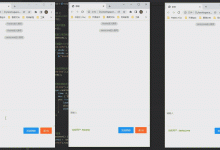String
public final class Stringimplements java.io.Serializable, Comparable<String>, CharSequence,Constable, ConstantDesc {...}
1. value数组
用于存储String的字符。
@Stableprivate final byte[] value;
@Stable
注解表示变量最多被修改一次,称为“稳定的”。
2. checkBoundsOffCount和checkBoundsBeginEnd方法
String的很多构造方法使用了数组或者其他一些集合来创建新的String,这些构造方法大多含有以下参数
- 集合S
- 取值左端点p
- 取值长度l
那么需要一个方法来检查这几个参数是否合法,所以String类提供了
checkBoundsOffCount()
方法
static void checkBoundsOffCount(int offset, int count, int length) {if (offset < 0 || count < 0 || offset > length - count) {throw new StringIndexOutOfBoundsException("offset " + offset + ", count " + count + ", length " + length);}}
如下是一个以bytes数组初始化String的例子,使用了上述方法。
public String(byte bytes[], int offset, int length, String charsetName)throws UnsupportedEncodingException {if (charsetName == null)throw new NullPointerException("charsetName");// 检查参数边界合法性checkBoundsOffCount(offset, length, bytes.length);StringCoding.Result ret =StringCoding.decode(charsetName, bytes, offset, length);this.value = ret.value;this.coder = ret.coder;}
同时,还有一个
checkBoundsBeginEnd()
方法
static void checkBoundsBeginEnd(int begin, int end, int length) {if (begin < 0 || begin > end || end > length) {throw new StringIndexOutOfBoundsException("begin " + begin + ", end " + end + ", length " + length);}}
这个方法可以检查begin、end以及length是否适配
3. COMPACT_STRINGS常量
static final boolean COMPACT_STRINGS;static {COMPACT_STRINGS = true;}
这个常量用于表示是否支持字符串压缩,默认为true。
在
coder()
方法内,要求返回String的编码,它是这样实现的。
byte coder(){return COMPACT_STRINGS ? coder : UTF16;}
如果支持字符串压缩,就正常返回该字符串的coder,否则必须使用UTF16。
4. length方法
public int length() {return value.length >> coder();}
获取value的长度,再根据字符集进行处理。
coder()
的返回结果如
LATIN1
、
UTF16
等都是字节常量。
@Native static final byte LATIN1 = 0;@Native static final byte UTF16 = 1;
5. getChars方法
public void getChars(int srcBegin, int srcEnd, char dst[], int dstBegin)
这个方法可以将String中的一部分转化字符存到chars数组中。下面是一个简单的使用示例。
public static void main(String[] args) {String s = "abc";char[] cs = new char[50];s.getChars(0,2,cs,0);System.out.println(cs);}
输出
ab
6. comepareTo方法
public int compareTo(String anotherString) {byte v1[] = value;byte v2[] = anotherString.value;byte coder = coder();if (coder == anotherString.coder()) {return coder == LATIN1 ? StringLatin1.compareTo(v1, v2): StringUTF16.compareTo(v1, v2);}return coder == LATIN1 ? StringLatin1.compareToUTF16(v1, v2): StringUTF16.compareToLatin1(v1, v2);}
当调用String的compareTo方法时,会根据字符串的编码类型选择不同类的静态方法。而它们内部实现compare的算法都是类似的。下面给出一个例子。
// StringLating类public static int compareTo(byte[] value, byte[] other, int len1, int len2) {int lim = Math.min(len1, len2);for (int k = 0; k < lim; k++) {if (value[k] != other[k]) {return getChar(value, k) - getChar(other, k);}}return len1 - len2;}
7. hashCode方法
String的哈希方法采用这个公式:s[0]*31^{(n-1)} + s[1]*31^{(n-2)} + \\cdots + s[n-1]
public int hashCode() {int h = hash;if (h == 0 && !hashIsZero) {h = isLatin1() ? StringLatin1.hashCode(value): StringUTF16.hashCode(value);if (h == 0) {hashIsZero = true;} else {hash = h;}}return h;}
下面是
StringLatin.hashCode()
public static int hashCode(byte[] value) {int h = 0;for (byte v : value) {h = 31 * h + (v & 0xff);}return h;}
8. replaceAll和replaceFirst方法
public String replaceAll(String regex, String replacement) {return Pattern.compile(regex).matcher(this).replaceAll(replacement);}public String replaceFirst(String regex, String replacement) {// 用regex表示的正则表达式去匹配当前字符串,再调用Matcher.replacereturn Pattern.compile(regex).matcher(this).replaceFirst(replacement);}
replaceAll()
和
replaceFirst()
方法接受
regex
参数和
replacement
参数。
Pattern
类从调用
compile()
方法解析正则表达式
regex
返回一个
Mathcher
,再调用它的
replaceAll()
或
replaceFirst()
方法。
9. LATIN1和UTF16
String类中定义了LATIN1和UTF16两个编码格式
@Native static final byte LATIN1 = 0;@Native static final byte UTF16 = 1;
- ISO Latin-1是8比特的字符集,定义了256个字符。前128个字符(00000000-01111111)与ASCII完全一致。所以使用LATIN1作为编码格式时,往往要通过
&0xff
的方式取低八位
 爱站程序员基地
爱站程序员基地


